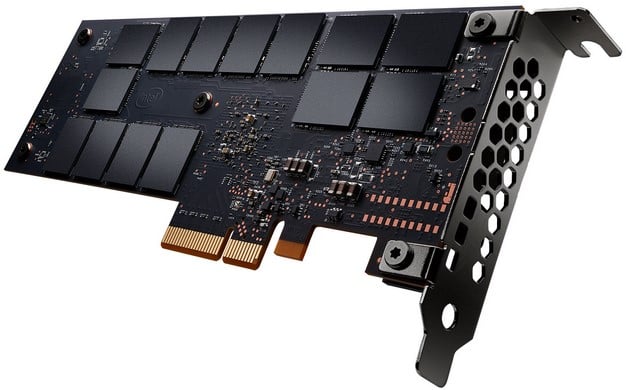Intel Optane SSD DC P4800X With 3D Xpoint Memory Debuts Ultra-Low Latency Storage, New Memory Tier
Today we have some news regarding the first product that Intel will ship leveraging 3D Xpoint memory technology, the brand new Intel Optane SSD DC P4800X. The SSD DC P4800X resembles some of Intel’s previous enterprise storage products, but most assuredly, this product is virtually all new, from its controller to its memory storage media.
Before we dig into some specifics, we should explain the branding. Optane is Intel’s branding for the entire collection technologies that make 3D Xpoint memory available to a system. Optane and 3D Xpoint are not interchangeable, but all of the initial Optane-branded products leverage 3D Xpoint technology – make sense?
The Intel Optane SSD DC P4800X will initially be offered in three capacities, though the 375GB model will be the first to arrive; the higher capacity drives will be coming a little later in Q2. The SSD DC P4800X will also be offered in two bundles, one that features the drive on its own and another that includes a piece of software that enables something called Intel Memory Drive technology. Intel Memory Drive Technology gives users the ability to leverage the SSD DC P4800X as system memory. It is essentially a piece of middleware, like a hypervisor for system memory, that takes the P4800X’s storage and the memory space, and presents it as a single pool to the operating system. There is an additional cost associated with Intel Memory Drive Technology, but exactly what that cost is wasn’t disclosed. At this time, it is only supported on Intel Xeon processors as well. Intel Memory Drive technology enables system to work on much larger data sets, without loading the systems up with massive amounts of more-expensive DRAM.
The Intel Optane SSD DC P4800X features a custom built, multi-channel (7 channel) controller architected and tuned for the 3D Xpoint media used on the drive. Although the drive is similar to other NVMe-based products in Intel’s current stack of enterprise storage products, there are some major differences over and above the 3D Xpoint media used on the Optane SSD DC P4800X.

The preliminary specifications listed above hint at some of those differences. The drive’s throughput doesn’t seem to be in another class versus other high-end, enterprise NVMe storage products, but note that its 4K IOPS ratings, with fully random and mixed 70/30 workloads, are at low queue depths. The Intel Optane SSD DX P4800X shines at low queue depths, where NAND flash-based storage products tend to lag behind. The drive’s endurance is also exceptionally high. The 375GB model that will initially hit the market is rated for 30 drive writes per day or 12.3 Petabytes Written, which Intel says is a conservative estimate.

Intel Optane drives based on 3D Xpoint media don't require over-provisioning like NAND-based SSDs. The random write performance of a NAND-based SSD can be improved by increasing the amount of spare space, because it makes defragmentation more efficient. Since 3D XPoint memory is write-in-place media, there is no defragmentation needed, and therefore no performance to be gained by over-provisioning. Some spare space is used to store ECC and metadata to maintain low error rates throughout the life of the drive, but Optane drives are not over-provisioned in the traditional sense. We should also note that there are significant differences in the 3D XPoint media versus NAND. For example, NAND features lots of extra capacity inside every die for sparing out blocks, as well as managing ECC code words. 3D XPoint memory media does not have or require the extra capacity, so over-provisioning doesn't really apply. With that said, spare capacity beyond the user defined area is leveraged for ECC, firmware, and other maintenance operations.
The Intel Optane SSD DX P4800X also handles requests different. For example, when a read request comes into the drive, the normal read write paths are always in hardware, which exploits the low latency performance characteristics of the media. In addition, one read of 4KB is now spread across multiple channels and dies. With NAND-based SSDs today, 4KB reads usually leverage only a single channel. With Optane, the aggregate performance of multiple channels and dies, result is higher realized performance. There is also no need to perform defrag operations, so the combination of firmware and write in place media results in low latency, in the neighborhood of 10 microseconds, and high quality of service. If you're wondering about the specific configuration of the DC P4800X, the 375GB drive has 4 pieces of media die per channel, or 28 die total.
Some of the product's performance expectations are outlined in the slide above. Versus the Intel SSD DC P3700, the new Optane SSD DC 4800X offers much higher performance in many scenarios, sometimes many times that of Intel's NAND-based SSD DC P3700 drive. Performance with sequential transfers wasn’t given, and we haven’t been able to run our own numbers just yet, but large sequential transfers are not where the DC P4800X will shine. It’s in regard to access times and responsiveness, as well as reliability under load, where the drives will stand out. We have some more specific performance expectations listed on the next page.
Also note that the Intel Optane SSD DC P4800X will be offered in both PCIe add-in-board and U.2 form factors, but availability of the different capacities and form factors will vary.









